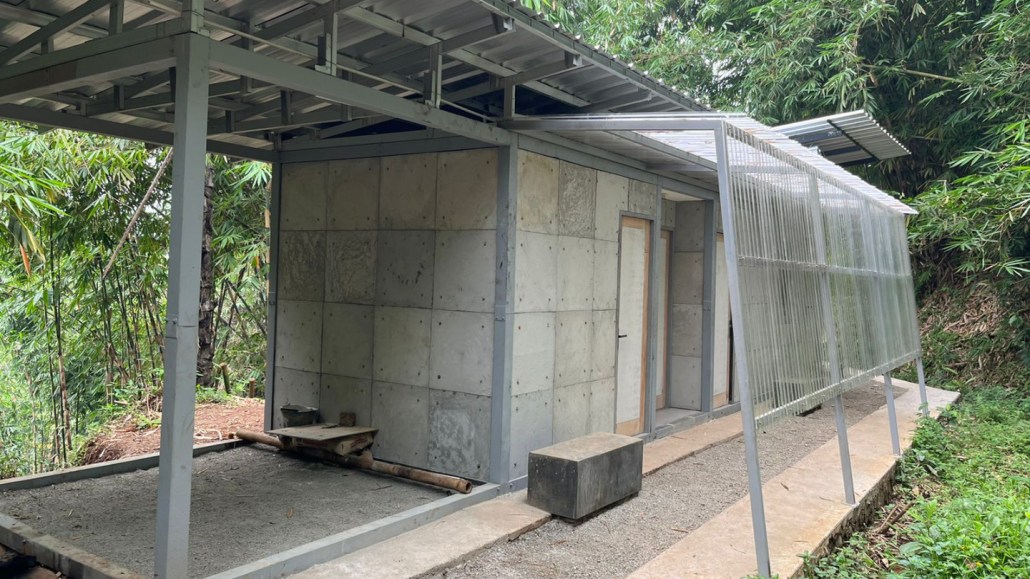This house is partly made of recycled diapers
Turning used diapers into building materials could cut landfill waste and housing costs

This single-story home in Indonesia was built partly with shredded, recycled diapers. Turning diapers into building materials could help the country meet two needs. It could make housing more affordable and reduce waste, researchers say.
Muhammad Arief Irfan
Share this:
- Share via email (Opens in new window) Email
- Click to share on Facebook (Opens in new window) Facebook
- Click to share on X (Opens in new window) X
- Click to share on Pinterest (Opens in new window) Pinterest
- Click to share on Reddit (Opens in new window) Reddit
- Share to Google Classroom (Opens in new window) Google Classroom
- Click to print (Opens in new window) Print
There are diapers in this house — but not where you might think. Used diapers partly make up its floors, columns and walls.
A team of researchers tested used diapers as one ingredient in building material. To build a new house, the team mixed recycled disposable diapers into concrete and mortar. Mortar is used to hold bricks together.
The team designed a single-story home that covers about 36 square meters (388 square feet). Recycled diapers could replace nearly 2 cubic meters (71 cubic feet) of its building materials. These findings appeared May 18 in Scientific Reports.
Repurposing diapers to make building materials would shrink the amount of trash that goes to a landfill. It could also make homes more affordable, the team says. That’s a big need in developing countries such as the Southeast Asian nation of Indonesia. There, demand for low-cost housing outstrips what’s available.
The number of people in Indonesia’s cities has climbed by about 4 percent per year in the last 30 years. And more people are moving to the country’s urban centers. By 2025, more than two-thirds of Indonesians are expected to live in urban areas, says Siswanti Zuraida. An environmental engineer, she works at the University of Kitakyushu in Japan. Zuraida is from Indonesia. All the waste people make is becoming a problem, she says. And Indonesia’s population boom is straining the demand for housing.
Building materials — especially those that make for strong structures — are often expensive. They’re often the biggest barrier to making homes affordable. So researchers have previously investigated unusual materials that could save costs. These materials included many that would otherwise pile up as waste, such as the husks of rice grains or fly ash. That’s the fine particles left over from burning coal.
Maybe giving old diapers a new use could help tackle both problems. Used disposable diapers mostly pile up in landfills or get burned. But disposable diapers contain wood pulp, cotton and plastic. All of those are potentially useful building materials.
A diaper change
Mortar and concrete are typically made from sand, gravel and other materials. Zuraida and colleagues tried replacing some of those materials with used diapers. Then they tested their mixtures to see if structures built with them would be strong enough.
The diapers have to be cleaned up before being reused. The team washed, dried, sterilized and shredded diapers. Then they made six different samples of concrete and mortar. Each used differing amounts of diapers, cement, sand, gravel and water. Crushing the samples in a machine revealed how much weight each could bear. Adding more diaper material reduced the strength of the mixture, they found.
The team designed and built a small home based on the maximum amount of diaper waste they found they could use. Their one-story house had two bedrooms and one bathroom. Recycled diapers could replace up to 27 percent of the typical materials used in load-bearing structures. Those are the structures that help hold up a building, such as columns and beams.

Taller buildings can’t use as much diaper material, the team found. A three-story home could use up to 10 percent disposable diapers in load-bearing structures. But other parts of homes don’t have to support a lot of weight. Those include garden paving blocks and walls that divide rooms. There, shredded diapers could replace up to 40 percent of the sand.
But there are big hurdles to adopting diapers or other unusual building materials, Zuraida says.
Diapers’ plant-based fibers can be used for building. But their plastic parts would have to be separated out. That takes a complicated process that, for now, is available only in developed nations. And Indonesia’s laws restrict what materials can be used for construction. Right now, it’s just concrete, bricks, wood and ceramics. (Making such materials emits a lot of greenhouse gases.)
The idea of building with waste is worthwhile, says Christof Schröfl. A chemist, he works at Technische Universität Dresden in Germany. Schröfl wasn’t part of the new work. But reusing diapers might not be that environmentally friendly, he says, especially on a large scale. It’s tricky to separate dirty diapers from waste and sanitize them. So it would take a lot of energy to recycle diapers.






